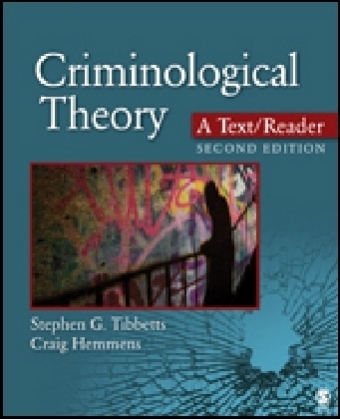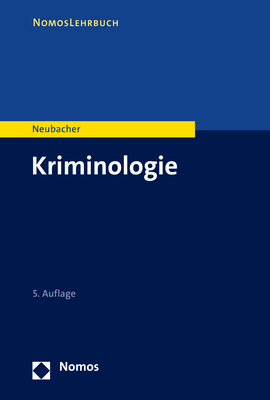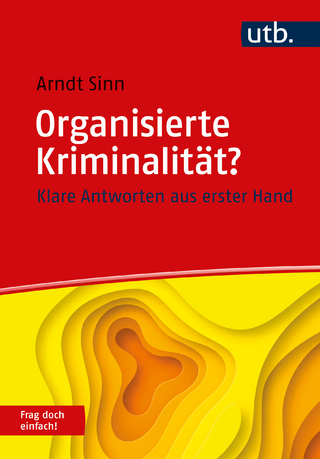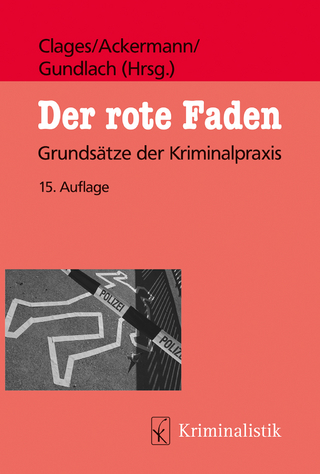
Criminological Theory: A Text/Reader
SAGE Publications Inc (Verlag)
978-1-4522-5815-7 (ISBN)
- Titel erscheint in neuer Auflage
- Artikel merken
The most accessible and comprehensive book for criminological theory courses available today, Criminological Theory: A Text/Reader, Second Edition provides the best of both worlds—substantial but brief authored sections on all of the major course topics, followed by carefully edited, policy-oriented, original research articles covering criminological theory from past to present and beyond. The Second Edition’s dozens of articles reflect both classic studies and state-of-the-art research. Designed throughout to enhance understanding, the book includes a helpful "How to Read a Research Article" before the first reading, as well as article introductions, photographs, and discussion questions that capture student interest and help them develop their critical thinking skills. The new 2nd edition has added 8 new readings that are more recent and applicable to theoretical models discussed in text.
Stephen G. Tibbetts, currently a Professor at California State University, San Bernardino, has been pursuing an understanding of criminal offending for over the past two decades. He has attempted to discover the extent to which individuals’ inherent dispositions and attitudinal traits contribute to their offending decisions, especially in relation to other factors, such as demographic, developmental, and situational factors. Dr. Tibbetts’ research has included work on the differences between men and women in their decisions to commit deviant behavior, as well as their perceptions of risk and consequences of getting caught. His additional research interests include the effects of perinatal disorders as an influence in future criminality, the etiology of white-collar crime, and gang intervention. Dr. Tibbetts has published nine books and more than 50 scholarly papers examining various issues in criminology. He received the 2011 Outstanding Professor Award at CSU, San Bernardino. He previously worked extensively as an Officer of the Court in providing recommendations for dispositions of numerous juvenile court cases from 1997 to 2008. Craig Hemmens is a professor in the Department of Criminal Justice and Criminology at Washington State University. He holds a JD from North Carolina Central University School of Law and a PhD in criminal justice from Sam Houston State University. Professor Hemmens has published 20 books and more than 200 articles, many dealing with legal issues in criminal justice. He currently serves as editor of the Criminal Law Bulletin and previously served as the editor of the Journal of Criminal Justice Education and as president of the Academy of Criminal Justice Sciences. His current research interests include criminal law and procedure.
SECTION I: Introduction to the Book: An Overview of Issues in Criminological Theory
Reading 1. The Use and Usefulness of Criminology, 1751–2005: Enlightened Justice and Its Failures by Lawrence W. Sherman
SECTION II: Pre-Classical and Classical Theories of Crime
Reading 2. On Crimes and Punishments by Cesare Beccaria
Reading 3. Capital Punishment and Deterrence: Examining the Effect of Executions on Murder in Texas by Jon Sorensen, Robert Wrinkle, Victoria Brewer, and James Marquart
SECTION III: Modern Applications of the Classical Perspective: Deterrence, Rational Choice, and Routine Activities or Lifestyle Theories of Crime
Reading 4. The Effects of Focused Deterrence Strategies on Crime: A Systematic Review and Meta-Analysis of the Empirical Evidence by Anthony A. Braga and David L. Weisburd
Reading 5. Specifying the Direct and Indirect Effects of Low Self-Control and Situational Factors in Offenders’ Decision Making: Toward a More Complete Model of Rational Offending by Alex R. Piquero and Stephen G. Tibbetts
Reading 6. Hot Spots of Predatory Crime: Routine Activities and the Criminology of Place by Lawrence W. Sherman, Patrick R. Gartin, and Michael E. Buerger
Reading 7. The Impact of Neighborhoods, Schools, and Malls on the Spatial Distribution of Property Damage by Teresa C. LaGrange
SECTION IV: Early Positive School Perspectives of Criminality
Reading 8. The Criminal Man (L’uomo delinquente) by Cesare Lombroso (as translated by Mary Gibson and Nicole H. Rafter)
Reading 9. The Contribution of Family Adversity and Verbal IQ to Criminal Behavior by Chris L. Gibson, Alex R. Piquero, and Stephen G. Tibbetts
Section V: Modern Biosocial Perspectives of Criminal Behavior
Reading 10. A Theory Explaining Biological Correlates of Criminality by Lee Ellis
Reading 11. Neuroimaging Studies of Aggressive and Violent Behavior: Current Findings and Implications for Criminology and Criminal Justice by Jana L. Bufkin and Vickie R. Luttrell
Reading 12.A Life-Course Analysis of the Criminogenic Effects of Maternal Cigarette Smoking During Pregnancy: A Research Note on the Mediating Impact of Neuropsychological Deficit by Jean Marie McGloin, Travis C. Pratt, and Alex R. Piquero
SECTION VI: Early Social Structure and Strain Theories of Crime
Reading 13. Social Structure and Anomie by Robert K. Merton
Reading 14. There’s a Darkness on the Edge of Town: Merton’s Five Modes of Adaptation in the Lyrics of Bruce Springsteen by Craig Hemmens
Reading 15.Building on the Foundation of General Strain Theory: Specifying the Types of Strain Most Likely to Lead to Crime and Delinquency by Robert Agnew
SECTION VII: The Chicago School and Cultural and Subcultural Theories of Crime
Reading 16.Delinquency Rates and Community Characteristics by Clifford R. Shaw and Henry D. McKay
Reading 17.Replicating Sampson and Groves’s Test of Social Disorganization Theory: Revisiting a Criminological Classic by Christopher T. Lowenkamp, Francis T. Cullen, and Travis C. Pratt
Reading 18.Peaceful Warriors: Codes for Violence among Adult Male Bar Fighters by Heith Copes, Andy Hochstetler and Craig Forsyth
SECTION VIII: Social Process and Learning Theories of Crime
Reading 19.A Sociological Theory of Criminal Behavior by Edwin H. Sutherland
Reading 20.A Social Learning Theory of Crime by Ronald L. Akers
Reading 21.Do Women and Men Differ in Their Neutralizations of Corporate Crime? by Lynne M. Vieraitis, Nicole Leeper Piquero, Alex R. Piquero, Stephen G. Tibbetts, and Michael Blankenship
Reading 22.Scared Kids, Unattached Kids, or Peer Pressure: Why Do Students Carry Firearms to School by David C. May
SECTION IX: Social Reaction, Critical, and Feminist Models of Crime
Reading 23.Informal Reactions and Delinquency by Lening Zhang
Reading 24.Conflict Theory and Deviance in Sport by D. Stanley Eitzen
Reading 25.Intersections of Race, Class, Gender, and Crime: Future Directions for Feminist Criminology by Amanda Burgess-Proctor
SECTION X: Life-Course Perspectives of Criminality
Reading 26.Criminal Career Paradigm: Background, Recent Developments, and the Way Forward by Alex R. Piquero, David P. Farrington, and Alfred Blumstein
Reading 27.The Effects of Prenatal Problems, Family Functioning, and Neighborhood Disadvantage in Predicting Life-Course Persistent Offending by Michael G. Turner, Jennifer L. Hartman, and Donna M. Bishop
Reading 28.Highlights From Pathways to Desistance: A Longitudinal Study of Serious Adolescent Offenders by Edward P. Mulvey
SECTION XI: Integrated Theoretical Models and New Perspectives of Crime
Reading 29. An Integrated Theoretical Perspective on Delinquent Behavior by Delbert S. Elliott, Suzanne S. Ageton, and Rachelle J. Canter
Reading 30.An Exploratory Test of Braithwaite’s Reintegrative Shaming Theory by Carter Hay
Reading 31.Toward an Interactional Theory of Delinquency by Terence P. Thornberry
SECTION XII: Applying Criminological Theory to Policy
Reading 32. Crime and Public Policy by James Q. Wilson
Reading 33. Toward an Integrated Theory of Probation by Craig S. Schwalbe
| Verlagsort | Thousand Oaks |
|---|---|
| Sprache | englisch |
| Maße | 187 x 231 mm |
| Gewicht | 780 g |
| Themenwelt | Recht / Steuern ► Strafrecht ► Kriminologie |
| ISBN-10 | 1-4522-5815-5 / 1452258155 |
| ISBN-13 | 978-1-4522-5815-7 / 9781452258157 |
| Zustand | Neuware |
| Informationen gemäß Produktsicherheitsverordnung (GPSR) | |
| Haben Sie eine Frage zum Produkt? |
aus dem Bereich



